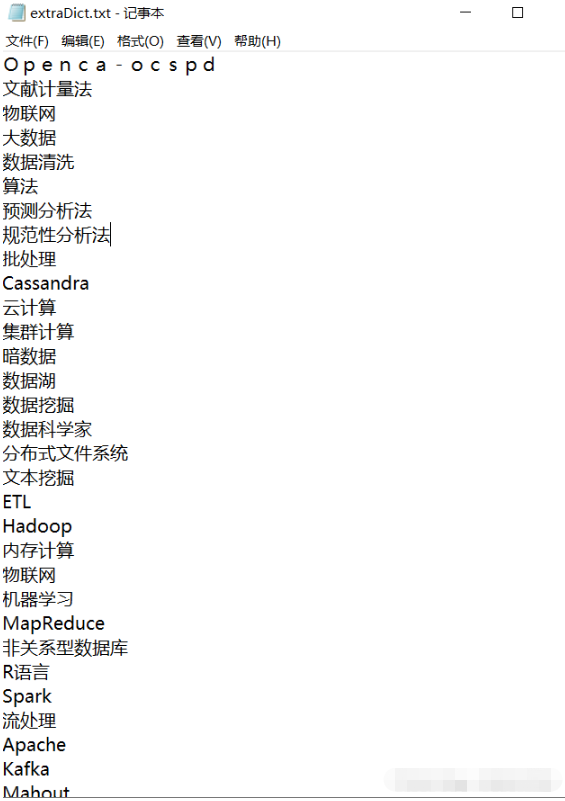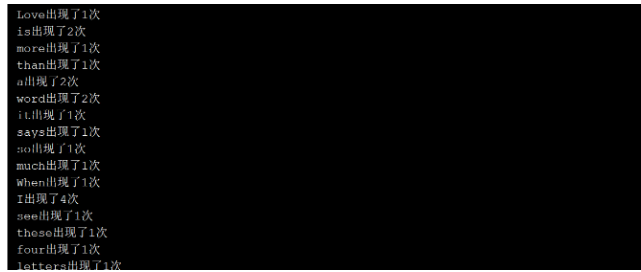这篇文章主要介绍“python中文分词和词频统计如何实现”,在日常操作中,相信很多人在python中文分词和词频统计如何实现问题上存在疑惑,小编查阅了各式资料,整理出简单好用的操作方法,希望对大家解答”python中文分词和词频统计如何实现”的疑惑有所帮助!接下来,请跟着小编一起来学习吧!
一、文本导入
我准备了一个名为abstract.txt的文本文件

接着是在网上下载了stopword.txt(用于结巴分词时的停用词)

有一些是自己觉得没有用加上去的
另外建立了自己的词典extraDict.txt

准备工作做好了,就来看看怎么使用吧!
二、使用步骤
1.引入库
代码如下:
import jiebafrom jieba.analyse import extract_tagsfrom sklearn.feature_extraction.text import TfidfVectorizer2.读入数据
代码如下:
jieba.load_userdict('extraDict.txt') # 导入自己建立词典3.取出停用词表
def stopwordlist(): stopwords = [line.strip() for line in open('chinesestopwords.txt', encoding='UTF-8').readlines()] # ---停用词补充,视具体情况而定--- i = 0 for i in range(19): stopwords.append(str(10 + i)) # ---------------------- return stopwords4.分词并去停用词(此时可以直接利用python原有的函数进行词频统计)
def seg_word(line): # seg=jieba.cut_for_search(line.strip()) seg = jieba.cut(line.strip()) temp = "" counts = {} wordstop = stopwordlist() for word in seg: if word not in wordstop: if word != ' ': temp += word temp += '\n' counts[word] = counts.get(word, 0) + 1#统计每个词出现的次数 return temp #显示分词结果 #return str(sorted(counts.items(), key=lambda x: x[1], reverse=True)[:20]) # 统计出现前二十最多的词及次数5. 输出分词并去停用词的有用的词到txt
def output(inputfilename, outputfilename): inputfile = open(inputfilename, encoding='UTF-8', mode='r') outputfile = open(outputfilename, encoding='UTF-8', mode='w') for line in inputfile.readlines(): line_seg = seg_word(line) outputfile.write(line_seg) inputfile.close() outputfile.close() return outputfile6.函数调用
if __name__ == '__main__': print("__name__", __name__) inputfilename = 'abstract.txt' outputfilename = 'a1.txt' output(inputfilename, outputfilename)7.结果

附:输入一段话,统计每个字母出现的次数
先来讲一下思路:
例如给出下面这样一句话
Love is more than a word
it says so much.
When I see these four letters,
I almost feel your touch.
This is only happened since
I fell in love with you.
Why this word does this,
I haven’t got a clue.
那么想要统计里面每一个单词出现的次数,思路很简单,遍历一遍这个字符串,再定义一个空字典count_dict,看每一个单词在这个用于统计的空字典count_dict中的key中存在否,不存在则将这个单词当做count_dict的键加入字典内,然后值就为1,若这个单词在count_dict里面已经存在,那就将它对应的键的值+1就行
下面来看代码:
#定义字符串sentences = """ # 字符串很长时用三个引号Love is more than a wordit says so much.When I see these four letters,I almost feel your touch.This is only happened sinceI fell in love with you.Why this word does this,I haven't got a clue."""#具体实现# 将句子里面的逗号去掉,去掉多种符号时请用循环,这里我就这样吧sentences=sentences.replace(',','') sentences=sentences.replace('.','') # 将句子里面的.去掉sentences = sentences.split() # 将句子分开为单个的单词,分开后产生的是一个列表sentences# print(sentences)count_dict = {}for sentence in sentences: if sentence not in count_dict: # 判断是否不在统计的字典中 count_dict[sentence] = 1 else: # 判断是否不在统计的字典中 count_dict[sentence] += 1for key,value in count_dict.items(): print(f"{key}出现了{value}次")输出结果是这样:

到此,关于“python中文分词和词频统计如何实现”的学习就结束了,希望能够解决大家的疑惑。理论与实践的搭配能更好的帮助大家学习,快去试试吧!若想继续学习更多相关知识,请继续关注编程网网站,小编会继续努力为大家带来更多实用的文章!





